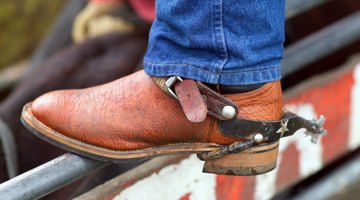How to Identify My Cowboy Spurs
Much like fine china manufacturers mark their products or ceramics makers mark their planters and pots with unique identifying symbols or names or numbers, smiths do the same to their spurs.

Things You Will Need
- Spur catalogs
- Internet resources
Blacksmiths have been marking their spurs partly for pride in workmanship, partly to identify the specific style and, in some cases, to identify when the spurs were manufactured. There is no standard marking procedure so the spur could be stamped anywhere except the rowel (the pointed disc). Most commonly, blacksmiths put their stamp on the heel band or yoke--the U-shaped metal that curves around the rear of the boot to which the shank and rowel are attached.
-
Start by looking thoroughly on the outside of the yoke, also known as the heel band. Most often the marking would be stamped on the outside of the yoke but it could be stamped on the inside. Vanity usually dictated that the stamp was on the outside so people could readily identify the maker. Depending on the age of the spur, markings could be worn if the spurs were heavily used. While the most widely manufactured spurs contain a branding mark, some custom-made spurs manufactured by smaller blacksmiths may not contain any branding.
-
Check the neck of the spur if you can't find any distinguishing marks on the yoke. Although more commonly marked on the yoke, smiths were free to put their stamp wherever they wanted. Bauerman spurs are marked in one of the most unusual locations and sometimes difficult to locate due to wear and age. They were stamped with the star brand behind the strap lug. Buermann custom designed spurs are stamped with the letters AB in an even more discreet location inside the yoke band. In 1914, Bauerman was purchased by North and Judd and the star brand was shrunk and moved to the area near the spur buttons. All other North and Judd spurs are branded with an anchor.
-
Look up the mark, name, initials or numbers on the spur. There are numerous catalogs that will help you find the most common types of spurs. If you fail to find the identifying marks in catalogs, try the Internet. Failing that, you may luck out by finding an old-timer working at a boot and saddle shop or on a ranch who can help you.
Tip
If the spurs are highly ornate, the more likely they are of Spanish or Mexican origin and the brand is usually affixed to a medallion somewhere obviously visible.
References
Tips
- If the spurs are highly ornate, the more likely they are of Spanish or Mexican origin and the brand is usually affixed to a medallion somewhere obviously visible.
Writer Bio
Chuck Ayers began writing professionally in 1982, breathing life into obituaries, becoming a political and investigative reporter at a major East Coast metropolitan newspaper. He now freelances and is a California communications and political consultant. He graduated from American University, Washington, D.C., with degrees in political science and economics.
Photo Credits
- rodeo boots and spurs image by Steve Lovegrove from Fotolia.com
- rodeo boots and spurs image by Steve Lovegrove from Fotolia.com
More Articles



